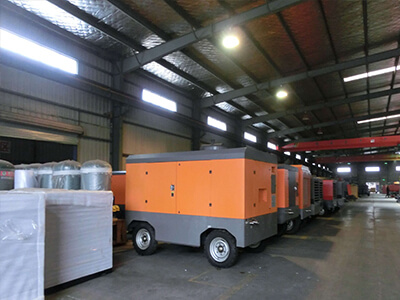Industrial Rotary Screw Air Compressors / Twin Screw(worm) Drive Air Compressor
A rotary screw air compressor is a kind of gas compression equipment. There are two types of Screw air compressors, Single screw drive, and twin-screw drive. A twin-screw drive air compressor is invented over a decade later than a single screw drive compressor. In terms of tech, Twin Screw(worm) air compressor is more excellent. The Two screw drive air compressor overcomes the problems of balance, and the wearing problems of Barings, the lifespan will be longer and it is more economic.
The air is compressed in a continuous sweeping motion, so there is less pulsation or surging of air, and a rotary screw air compressor is usually used to replace the piston air compressor where a large volume of air or high-pressure air is needed.
Working principle
There are two helical screws called rotors, the one has a crowned tooth called a male rotor, and the other one is called the female rotor has a concave tooth. The male rotor is connected to the engine, then the female is powered by a male rotor. Air enters from the inhale side and moves through the threads as the screws rotate. The meshing rotors force the air through the compressor, and the gas exits at the end of the screws. The effect of this mechanism is dependent on precisely fitting clearances between the helical rotors and between the rotors and the chamber for sealing of the compression cavities.

Advantages
Rotary screw compressor has low leakage levels, stable and low vibration, and low noises.
The supercharger is typically driven directly from the engine’s crankshaft gear drive or belt.
The twin-screw exhibits internal compression which is the ability of the device to compress air within the housing as it is moved through the device.
All supercharger types benefit from the use of an intercooler to reduce heat produced during pumping and compression.
Screw Air Compressor maintenance
- The operation, repair, and maintenance of the compressor must be carried out by qualified personnel.
- The compressor cannot be reversed. After the initial start or maintenance of the electronic control system, it must first be confirmed whether the direction of rotation of the motor is consistent with the specified direction before the compressor is started.
- When removing high-temperature components, it must be done after the temperature has cooled to ambient temperature.
- It is recommended to use special oil for screw compressors. Different grades of lubricants are not allowed to be mixed.
- Without the permission of the manufacturer, do not make any changes to the compressor that affects safety, reliability or add any equipment.
- The original spare parts of the compressor are specially designed and manufactured. It is recommended to use authentic spare parts to ensure the reliability and safety of the compressor.
- It is absolutely not allowed to block the compressor suction port during operation.
- Compressed air is never allowed for breathing purposes unless it is indicated that it can be used for breathing.
- The compressor cannot be operated above the specified pressure and the specified temperature.
- Once the compressor is found to be working abnormally, stop the compressor immediately and eliminate the abnormality in time.
- Maintain and repair the compressor with the correct tools.
- After repairing finished, confirm that all safety devices have been reinstalled and the tools have been removed from the compressor before starting.

Regular maintenance/checking
1. Everyday checking. Check the oil level, exhaust temperature and exhaust pressure, check if there are abnormal sounds;
- Weekly checking. Open the separator and check the drain valve and discharge condensate before starting, check if there are leaks everywhere, check the safety valve, check the belt wear (visual inspection);
- Regularly check the intake control valve, and the lowest pressure valve, electric control box, and connection line terminal, safety valve, cooling fan;
- Regularly clean, clean the cooler, test the reliability of the safety valve;
- Regularly change the oil filter core, oil separator filter, air intake filter element, and lubricant.

